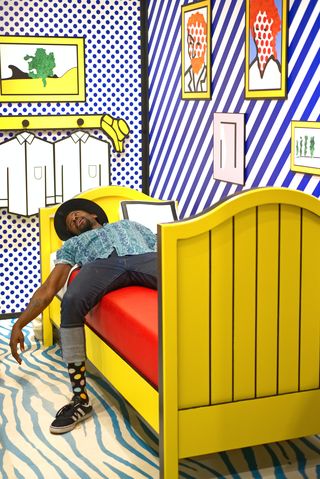Sleep
There's a Nap for That
In lockdown, there's a whole lot of napping going on. Because we can.
Posted April 29, 2020 Reviewed by Gary Drevitch

First let me say this post salutes those for whom a nap is an impossible luxury these days: the frontline workers answering a higher calling.
Among the rest of us, holed up helplessly at home, the days blurring one into the next, the contours of each amoeba-like, there is a lot of napping going on. Because we can. Heck, some of us barely change out of our napping attire.
In my house, the four of us — two parental units and two teenagers — have been trying to honour each other in our solitudes, as Goethe almost said. But solitude is hard to come by. So we rotate in and out of the prime napping spots, like hot-bunking sailors.
The shut-in life has made me appreciate the finer points of napping. Also the multiple specific uses of naps. Over the seasons of my life I have discovered one sterling truth: whatever the occasion, whatever the challenge, there’s a nap for that.
Most of the naps below I have deployed in the last four weeks — sometimes greedily, sometimes in desperation. But don’t let the homespun names fool you: These naps are backed by science.
Nano naps: 1-10 minutes
What the science says: There is a country, just beyond waking but not quite sleep, called hypnogogia. Interesting things happen there, if you can tap into them.
The Eureka Nap. Salvador Dali liked to settle into an armchair chair with a key in his outstretched hand. As he nodded off, his fingers would relax, and the key would clatter on the floor, waking him up. Whereupon he’d furiously jot down, before they faded, the hallucinogenic images his mind had coughed up.
This is a great nap when you’re stuck creatively. Some of us are stuck creatively more than usual at the moment.
Power naps: 10-20 minutes
What the science says: Even a short nap can boost alertness and productivity, improve athletic performance, and lift one’s mood.
The Equanimity Nap. As the lockdown drags on, everyone's getting in each other’s grill. This nap is a tonic. Even 20 minutes of shuteye has been shown to make people more chill.
The Coffee Nap. A favourite trick of college students, this nap, following a quickly downed cuppa, helps you combat drowsiness by surrendering to it — without actually slipping into a deep sleep. (The caffeine jolts you awake in 15 minutes.) These days, you may need that kind of alertness to figure out your kid's algebra problem while wrangling your own work commitments.
The Olga Nap. Named for the famed nonagenarian Canadian track athlete Olga Kotelko, this a pre-workout nap. (Before competing, Kotelko would find a quiet place, prop her legs against a fence or a tree, and doze off.) Even in quarantine, you must find a way to exercise — even if it’s just running up and down the stairs — lest you go mad.
Emergency/Replacement naps: 30-60 minutes
What the science says: These longer naps take you into slow-wave sleep that can consolidate memories, promote information retention, and balance the sleep-debt books.
The Edison Nap. Thomas Edison wasn’t much of a nighttime sleeper, but he was a champion napper. He could doze off anywhere – in a closet, on his work bench — and sleep “as sound as a bug in a barrel of morphine” before shaking off the cobwebs and plowing on. Great for when you’re in the zone or (more likely these days) on deadline.
The Disco Nap. For clubbers who aren’t as young as they once were. This prophylactic afternoon nap can give you the jam to push past your usual 10 pm bedtime on “date night.” These days, the only clubbing going on is virtual. Last weekend we played a Zoom version of the party game Encore, where you’re given a word and then have to sing a song with that word in it — a bruising test of long-term memory. I managed to squeeze in a 15-minute nap beforehand. According to sleep guru Matthew Walker, it probably helped.
The Procrastinator. Science hasn’t measured it but let’s just agree that naps are also way more delicious when you have something else you’re supposed to be doing. Such as, say, taking the dog for a walk. Luckily for our daughter, who has been using this nap expertly to avoid that task, the dog usually opts to nap with her rather than protest.
The Good Judgment Nap. Maybe the biggest decision in modern history fell on the shoulders of John F. Kennedy on October 27, 1962 — “Black Saturday” — when an American pilot was shot down over Cuba and the world expected him to retaliate. Kennedy’s judgment — and this gentleman’s, too — may have saved the world. There’s no solid evidence that “sleeping on it” leads to better decision-making, but a nap can’t hurt. Kennedy was faithful to his afternoon naps, even during the Cuban Missile Crisis.
The Immune-System Booster. COVID-19 preys on weak immune systems. So a nap before you, say, go shopping may provide peace of mind at the very least. This small study found that for people in sleep debt, two 30-minute naps restored neuroendocrine levels. “Our data suggest that napping has stress-releasing and immune effects.”
Full-Monty Naps: 90 minutes.
What the science says: A 90-minute nap takes you through a full sleep cycle. Benefits include memory consolidation, muscle repair, and a feeling of rest and restoration. Bonus benefit: no sleep hangover.
The Hail Mary Nap. On June 14, 2011, the day before the seventh and deciding game of the Stanley Cup final, the Boston Bruins were in tough against the (then) mighty Vancouver Canucks. Grasping at straws, the Bruins reached out to Charles Czeisler, the director of the Division of Sleep Medicine at Harvard Medical School. He suggested that the team take a nap. So the coach canceled the morning skate and the players snoozed instead. The rest is … broken windows in downtown Vancouver. The Bruins won, 4-0. (And Canucks fans back home rioted.)
A Hail Mary nap is a kind of secular prayer. It can’t hurt and it might help. These days, that’s reason enough to try.
The Fever-Dream Nap. While real-world adventures are hard to come by right now, you can still gin them up in our own subconscious. You need a full 90-minute sleep-cycle to get the REM sleep that delivers dreams. Throw a heavy blanket over yourself in a warm room to crank up the intensity. (An actual fever works too, though getting sick probably ought not to be Plan A.) There’s some evidence that you’re more likely to dream if you nap in the morning than in the afternoon. And the good news is that, because you pop up like toast right after, you’ll remember most of it. But be warned: the bad-dream-to-good-dream ratio is high right now. Reports of “lockdown nightmares” abound.
The Houdini Nap. From the emerging field of desperately McGyvered parental improvisations, meet Michael Weber. Not long ago, the exhausted Colorado father was left alone with his four young children while his wife Monica went grocery shopping. His problem was almost one of quantum physics. He needed to be in two places at once, or rather, doing two different things: babysitting and napping. Weber draped himself in a blanket, equipped the kids with little easels and pencils, and conducted a still-life drawing class while he napped. The experiment is now being replicated by shut-in fathers everywhere.




